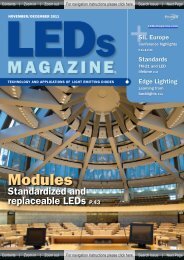LED drivers Phosphor technology - Beriled
LED drivers Phosphor technology - Beriled
LED drivers Phosphor technology - Beriled
You also want an ePaper? Increase the reach of your titles
YUMPU automatically turns print PDFs into web optimized ePapers that Google loves.
Figure 1. Converter and EMI Filter Schematic.<br />
Only 25 components are required for the design for both converter and<br />
EMI filter, exclusive of PCBs and interconnects. A complete parts list for<br />
the design can be found in the referenced material.<br />
The electrical design for this application is fairly conventional for this<br />
proven power conversion IC. The biggest challenge was the mechanical<br />
design, specifically integrating both the converter and the EMI filter into<br />
standard lamp housings. However, this design fits comfortably into either<br />
a screw-in Edison base (E27) or the bayonet halogen socket (GU 10).<br />
(Dimensions for the halogen bayonet socket are shown in Figure 2.)<br />
Early on in the design process it<br />
became clear that a circular PCB<br />
large enough to house all the<br />
components for both the converter<br />
and the EMI filter would not<br />
fit into the lamp socket base. So<br />
a decision was made to partition<br />
the design onto two circular PCBs,<br />
one for the converter circuitry and<br />
another for the EMI filter. The final<br />
diameter of the converter board is<br />
Figure 2. Mechanical Packaging Challenge.<br />
19.66 mm while the diameter of<br />
the EMI filter board is 16.91 mm.<br />
These boards were then stacked and interconnected with discrete wires<br />
to complete the assembly.<br />
Although this design was functional, there was still a problem with conducted<br />
emissions. Because of the proximity of the two PCBs, there was<br />
coupling of switching currents from the converter board into the EMI<br />
Copyright © 2007 Luger Research & <strong>LED</strong> professional. All rights reserved.<br />
filter board, compromising the performance of the EMI filter. This situation<br />
was solved by the inclusion of a ‘shielding’ PCB between the other<br />
two boards. This third board is simply a layer of copper with no circuitry.<br />
It is electrically connected to the junction of the negative output<br />
of the EMI filter and the negative input to the converter board. The final<br />
assembly then consists of a stack of three circular boards. This simple<br />
and inexpensive addition solves the coupling problem and results in the<br />
EMI performance demanded.<br />
Performance<br />
The reference design meets all of the design objectives. When used<br />
with 120 Vac nominal input voltages, the circuit efficiency is over 62<br />
percent. The efficiency is over 56 percent with 220/240 Vac input voltages.<br />
Conducted EMI characterization was performed at both 115 Vac<br />
and 230 Vac inputs using both quasi-peak and average readings based<br />
on the EN55022A limits. The worst case configuration was at 230 Vac<br />
input, where the circuit passed with a margin of 7 dB. Margins were<br />
higher at 115 Vac input. Additional EMI plots along with waveforms of<br />
operation during both normal operation and start-up are included in<br />
the referenced test report.<br />
Figure 3. Compliance to EN55022A at Worst Case Input of 230 Vac.<br />
Conclusion<br />
In spite of the physical constraints, therefore, it is perfectly possible to<br />
integrate a high performance electronic ballast for a HB <strong>LED</strong> bulb into a<br />
standard lamp housing cost-effectively and still meet EMI and power<br />
quality standards. The design is extensively supported with application<br />
notes, design tools, and a new <strong>LED</strong> lighting microsite. The availability of<br />
the RDK-131 reference design will allow new HB <strong>LED</strong> lighting products<br />
to be introduced with a fast time-to-market and alleviate the current<br />
scarcity of offerings that address important EMI questions.<br />
www.led-professional.com <strong>LED</strong> professional Review | June 2007 | page 36

















